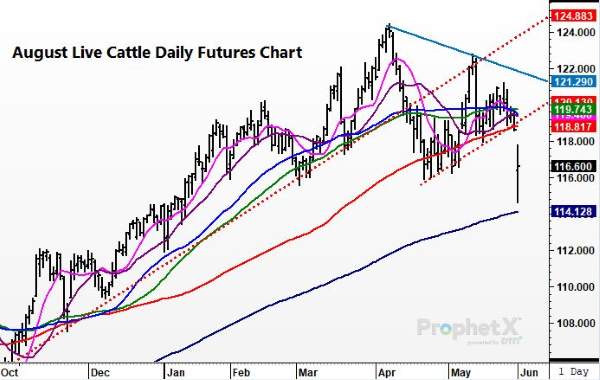Market Summary 06-01-2021
The cattle market got hit with some difficult news over the weekend as JBS, the number 1 beef producer in the U.S., got hit with a cyberattack. In response to this cyberattack, JBS closed approximately 1/5th of the slaughter capacity in the U.S. on Tuesday to recover from the issue. On top of that, Australian JBS facilities, and one of Canada’s largest beef plants were idle. The plant closures came at a difficult time following the Memorial Day holiday and packers need to catch up on retail orders. In addition, the slaughter capacity has been an issue this spring, and anything slowing the slaughter run more only backs up cattle supplies and weighs on the market prices. The live cattle market broke strongly lower, trading down just short of the $5.00 limit before finding some footing. There isn’t a timetable on the plant closures and when plants will be back to full capacity. The delay will probably be short-term. The cattle market has struggled to get any traction this spring, and this news only adds to the selling pressure.

CORN HIGHLIGHTS: Corn futures gained double digits on the overnight trade as forecasters indicated a warmer and drier outlook, especially for the northern tier of states. The market followed through to the close with Jul gaining 32 cents to finish at 6.88-3/4 and Dec 31-1/2 ending the session at 5.77. We mentioned the drier and warmer forecast late last week, yet into a long holiday weekend, there is plenty of time for forecasts to change which was reflected in a lower close on Friday. Now, the outlook may have even turned warmer and drier than indicated last week. Additionally, parts of the Midwest may have suffered frost damage over the weekend. While the total acres affected may be minimal, it’s another drop in the friendly/bullish bucket today. Stronger energy prices and a generally weak dollar are also influencers as crude oil pushed into new contract highs. A busy travel weekend and expectations that consumers are going to be traveling much more this summer are keeping supplies tight and helping to keep ethanol demand vibrant. Export inspections at 80.7 mb were supportive. A private firm downgraded the Brazilin crop to just under 90 mmt. The current USDA estimate is 102 mmt. Expectations coming into today is that 97% of the crop is planted and will be rated as 70 good to excellent. Weather is what matters from this point forward.
SOYBEAN HIGHLIGHTS: Soybean futures rallied sharply in the overnight/early morning session on calls for warmer and drier. Strong gains in corn and wheat also supported bean futures. Export inspections were termed neutral to friendly at 7.1 mb. This brings the yearly total to 2.074 bb, or 91% of the total forecasted sales of 2.280 bb. A warmer and drier forecast for the northern tier of states along with some concern of frost damage over the weekend also provided underlying support. Soybean oil was also firmer closing at its highest level in nine sessions. Soybean meal also gained near 3.00 per ton on futures. Yet, the soybean market seemed to be more of a follower of corn and wheat. Very tight supplies of soybeans were noted all spring, yet the world has turned its attention toward Brazil for purchasing supplies. This coupled with high prices could suggest a natural slow-down in demand. This was noted on the latest crush report where processors crushed less beans than expected. The technical picture is at a crossroads. Both bulls and bears will argue their bias, yet we see a market that has corrected and yet could be forming the right shoulder of a head and shoulders pattern that would point to downside. Weather holds the key.
WHEAT HIGHLIGHTS: Jul Chi up 30 cents at 6.93-1/2 & Dec up 28-1/2 cents at 7.03-1/4. Jul KC wheat up 30 cents at 6.37-1/2 & Dec up 24 cents at 6.56-1/4. After Friday’s downward close, wheat (and all fellow grains) surged today on an above to much above normal temperatures on the horizon for the remainder of the week. Little to no rains are still projected for the northern Plains, making the drought there worsen and spread – which explains why MNPLS wheat today led the pack and closed up 44 cents on the Jul contract. The Dakotas are expected to see temps over 100 degrees this week – zapping what little moisture was struggling to hold in those areas. The U.S. dollar continues to fall and looks to close below the low close of January 4th of 90.098. Normally we would look for this to help our export business but it’s unlikely U.S. wheat is still overpriced from a global standpoint but the fall in the U.S. dollar is supporting futures nonetheless. The Russian ag agency raised Russian production by 500,000 mt to 79.5 mmt, compared to USDA 85 mmt estimate. The dryness in southern Russia is resolved for now, but now the thought of “too much” rain is starting to be a concern as rains from last week and this past weekend were enough to satisfy crops, however more heavy rains on the horizon this week. Today’s Crop Progress report has winter wheat headed at 79% – right on pace with the 5-year average. Winter wheat condition reported at 48% – up 1% from last week. Spring wheat planting is 97% and condition at 43% – down 2% from last week.

